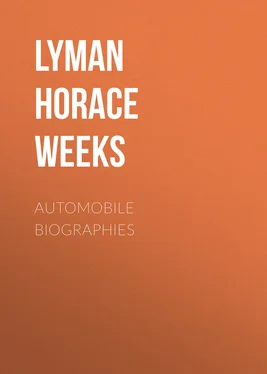Lyman Horace Weeks - Automobile Biographies
Здесь есть возможность читать онлайн «Lyman Horace Weeks - Automobile Biographies» — ознакомительный отрывок электронной книги совершенно бесплатно, а после прочтения отрывка купить полную версию. В некоторых случаях можно слушать аудио, скачать через торрент в формате fb2 и присутствует краткое содержание. Жанр: Биографии и Мемуары, auto_regulations, foreign_antique, на английском языке. Описание произведения, (предисловие) а так же отзывы посетителей доступны на портале библиотеки ЛибКат.
- Название:Automobile Biographies
- Автор:
- Жанр:
- Год:неизвестен
- ISBN:нет данных
- Рейтинг книги:5 / 5. Голосов: 1
-
Избранное:Добавить в избранное
- Отзывы:
-
Ваша оценка:
- 100
- 1
- 2
- 3
- 4
- 5
Automobile Biographies: краткое содержание, описание и аннотация
Предлагаем к чтению аннотацию, описание, краткое содержание или предисловие (зависит от того, что написал сам автор книги «Automobile Biographies»). Если вы не нашли необходимую информацию о книге — напишите в комментариях, мы постараемся отыскать её.
Automobile Biographies — читать онлайн ознакомительный отрывок
Ниже представлен текст книги, разбитый по страницам. Система сохранения места последней прочитанной страницы, позволяет с удобством читать онлайн бесплатно книгу «Automobile Biographies», без необходимости каждый раз заново искать на чём Вы остановились. Поставьте закладку, и сможете в любой момент перейти на страницу, на которой закончили чтение.
Интервал:
Закладка:
For a time it looked as though the new vehicle was destined to a permanency and to accomplish a revolution in the methods of travel on the high-roads. But several things arose to determine otherwise. There sprang up an unreasoning senseless hostility to any substitute for the horse as the agent of vehicular traffic. The stage-coach drivers were afraid that they would be thrown out of work. Breeders of horses foresaw the destruction of their business, when horses should no longer be in demand. Farmers were sure that with horses superseded by steam, they would never be able to sell any more oats. This public animosity manifested itself wherever the steam carriages went. The coaches were hooted at and stoned amid cries of “down with machinery.” Stones and other obstacles were placed in the roads, trenches were dug to trap the unsuspicious driver and stretches of roadway were dug up and made into quagmires to stall the machines. Parliament was called upon and enacted excessive highway tolls, especially directed at steam carriages. Another law that stood on the statute books of Great Britain until within comparatively recent times compelled every self-propelled vehicle moving on the highway to be preceded by a man walking and carrying a red flag.
All this was undoubtedly due, in a large measure, if not wholly, to what was then known as the Turn Pike Trusts, which, in conjunction with the stage-line companies, in many cases, were owners of a thousand and more horses. The latter, quite naturally, objected to the introduction of the mechanical vehicle, while the former had such relations to them that both their interests were identical.
But above all things, the great art of railroading had already grown from infant existence to a condition of great possibilities, which were now to be finally determined by a success, not alone mechanical and in the eyes of the inventor, but measured by the balance sheets of the companies of individuals who had made possible the construction of the various experimental locomotives or experimental lines then being operated in England and elsewhere. Just at this time, in the thirties of the nineteenth century, seems to have been the crucial point. The arguments of the engineers on the question of sufficient traction of the iron-shod wheels on iron or other hard railways, while given due consideration, were not wholly convincing, at least to the people investing their money in the enterprises; the profits were to tell in the final conclusion, and it would seem that the great era of railroading might be considered to have had its actual birth at this time, because:
The first dividend was paid on one of the great railroad enterprises.
For the time being that seemed to sound the death knell of the common road steam-propelled vehicle. The engineers so strongly advocating the railroad had proven their various propositions in the eyes of those who had the financial powers to engage in the extensive introduction and development of the new means of transportation. Further demonstration, extensively exploited, was also made to the satisfaction of those investors, that vehicles could be pulled with less power on a hard roadbed such as a railway, than on an uneven and sometimes soft path such as common roads. It seems clear that these and various other arguments, heartily urged at that time, and, in some cases, unquestionable from a technical standpoint, were really decided by that first dividend. And the common road vehicle with the support and enthusiasm of its backers largely withdrawn from it dropped to a position greatly subordinate to the other branch of transportation.
On the other hand, the development which came in the next few decades in the railroad department brought also a renewed demand for common road vehicles for certain classes of work or for certain localities. The steam vehicle for stationary purposes, and also for the locomotive, were being rapidly developed and refined. The railroad settled down to the idea of a power unit drawing numerous wagons. That has been consistently adhered to to the present day, and only in the past decade have we gone back to the old and first principles of embodying the mechanical propelling means in the same vehicle that transports the passengers or goods. So, while Hancock and his worthy contemporaries passed into history, other common road steam advocates continued their isolated attempts up to and past the middle of the nineteenth century, although without any such general enthusiasm as prevailed in the twenties and early thirties.
Many attempts in America, such as those of Fisher, Dudgeon, and others, and the work in England by numerous inventors and machine manufacturers, such as Tangye, Hilditch, Snowden, F. Hill, Jr., aided by the engineers, Macadam, Telford and M’Neil, who were improving the common roads so that they might approach the advantageous conditions of the railroad, assume prominence in connection with that period of the history. Rickett’s carriage, in 1858; Carrett’s, in 1862; Boulton’s, in 1867; Catley’s, in 1869, and others, were among the finger-posts of that time, pointing to more notable achievements of the future.
But in England the Act of Parliament, passed in 1836 and in force almost to to-day, known as the Locomotive Act, was the deterrent to progress in common road steam locomotion. This condition even continued after the select committee of Parliament, in 1873, endeavored to remove some of the restrictions, but succeeded only in producing the Act of 1878, which in no way improved the position of the common road vehicle.
In France and on the Continent political conditions doubtless mitigated against any general advance, and though this period included the great development of machinery and construction which paved the way for the future, it is not of prominence in this history.
A new era may be said to have commenced in the early part of the seventies when we find Amédèe Bollèe exhibiting a steam machine at the Vienna Exposition. In the seventies were also experiments on modified forms of power on vehicle propelling motors other than steam, but it still seemed to be the steam vehicle that characterized the new period of activity which blossomed out in the early eighties with many ardent advocates, and exhibited a type of light vehicle with efficient strong boiler and light engine. America should not be overlooked, however, when we consider the one small vehicle of Austin, which was constructed in Massachusetts, and attracted great attention at the shows of the Ocean Circus, in the early seventies, or thereabout. Bouton, of France, came to the fore in the early eighties, and the light steam vehicle seemed on the high road to a great development and a monopoly of the common roads vehicle industry, until its competitor appeared in what is now popularly known as the gasoline vehicle in the middle eighties.
From this time on the great industry of to-day advanced in strides and jumps, but while the future had been anticipated in some suggestions and experiments in Europe, at last one great mind had delved into the problem and anticipated the great future of the new type of vehicle in America. Selden, after a decade or more of study and work, and well-directed experiments, had made his own deductions, and with clear discerning had concluded what, to his mind, would be the vehicle in the future. The result of his labors and the subsequent filing, in 1879, of a patent application, when considered in connection with his persistent work from that time on, even to the present day, would seem to justly mark him as the pioneer in this type of vehicle; in fact, he was so called by the Commissioner of Patents of the United States when publishing his annual report, immediately after the issue of Selden’s patent.
Читать дальшеИнтервал:
Закладка:
Похожие книги на «Automobile Biographies»
Представляем Вашему вниманию похожие книги на «Automobile Biographies» списком для выбора. Мы отобрали схожую по названию и смыслу литературу в надежде предоставить читателям больше вариантов отыскать новые, интересные, ещё непрочитанные произведения.
Обсуждение, отзывы о книге «Automobile Biographies» и просто собственные мнения читателей. Оставьте ваши комментарии, напишите, что Вы думаете о произведении, его смысле или главных героях. Укажите что конкретно понравилось, а что нет, и почему Вы так считаете.












